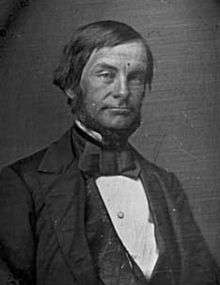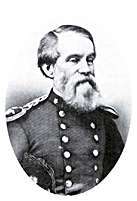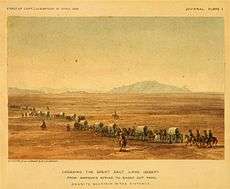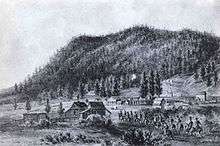James H. Simpson
James Hervey Simpson (1813–1883) was an officer in the U.S. Army and a member of the United States Corps of Topographical Engineers.


Early years
He was born in New Brunswick, New Jersey on March 9, 1813, the son of John Simpson and Mary Brunson. He graduated from the United States Military Academy in 1832 and was initially assigned to the 3rd U.S. Artillery. He served in the Second Seminole War and was promoted to first lieutenant in 1837.
Topographical Engineers
In 1838, a separate department known as the U.S. Army's Topographical Engineers was created (not to be confused with the Corps of Engineers with whom they were merged during the Civil War). Simpson was one of the officers transferred to the newly created bureau and assigned as an assistant to Cpt. W. G. Williams who was in charge of harbor construction on Lake Erie. The following year, he worked on road construction in Florida and then lake surveys in Wisconsin and Ohio. From 1845 to 1847, he was in charge of the harbor of Erie.
New Mexico Expedition, 1849
In 1849, Simpson surveyed areas in the American Southwest, between Santa Fe and the Navajo tribal lands. He had recruited wilderness artists Edward and Richard Kern to record the expedition in watercolors, oils, drawings and maps. He surveyed a road from Fort Smith, Arkansas to Sante Fe, New Mexico and then served for a year as the Chief Topographical Engineer for the Department of New Mexico.
Other Duties
After six months sick leave, Simpson returned to duty and was transferred to St. Paul, Minnesota in 1851 where he spent the next five years overseeing the roads of the territory. During this period, he was promoted to captain. From June 1856 to February 1858, Simpson was engaged in coastal survey of Florida.
Utah Expedition, 1858–59


In early 1858, Simpson was ordered to join the Army's reinforcements for the Utah War. He and his team resurveyed the trails from Fort Leavenworth to Utah and his photographer, Samuel C. Mills, produced the earliest surviving photographs of features along the trail. Upon his arrival at Camp Floyd, he was directed to open a new road between that post and Fort Bridger. Simpson and his team also surveyed the military reservation at Fort Bridger, at Camp Floyd and in the Rush Valley.
In May 1859, he headed an expedition to survey a new route from Camp Floyd (south of Salt Lake City) across the Great Salt Lake Desert of Utah and through the Great Basin to Genoa, Nevada near California. The Army contracted Frederick Lander to immediately to develop the more direct route to California for use by wagons, and Simpson's survey was later published in 1876.
Simpson's Central Route played a vital role in the transportation of mail, freight, and passengers between the established eastern states and California, especially when hostilities of the Civil War closed the Butterfield Overland Mail stagecoach route that ran along the southern border states. George Chorpenning immediately switched to Simpson's route to run his existing mail and stage line, and the Pony Express used it as well. In 1861 the Transcontinental Telegraph was laid along the route, making the Pony Express obsolete. Afterwards, Wells Fargo & Co. hauled mail, freight, and passengers along Simpson's route until 1869, when transportation and telegraphy were switched to the newly completed Transcontinental Railroad.
Civil War
During the American Civil War, Simpson served as colonel of the 4th New Jersey Volunteer Infantry and was captured at the Battle of Gaines's Mill. He was paroled and returned, but resigned his commission of volunteers on August 24, 1862 to return to his rank of major in the Corps of Topographical Engineers. He was attached to the Department of the Ohio and was in charge of the expansion and improvements of the defenses for Cincinnati, Ohio. For his services during the war, Simpson was brevetted to the rank of brigadier general.
Later career
Simpson was named chief engineer of the Interior Department. He oversaw the construction of the Transcontinental Railroad, the completion of which made his Central Nevada Route obsolete. In 1880 he retired to St. Paul, Minnesota, and died there on March 2, 1883.
The Simpson Park Mountains in central Nevada, a small range in west-central Utah (Simpson Mountains), and Simpson Springs Pony Express Station are all named after him.[1]
Bibliography
- Navajo Expedition: Journal of a Military Reconnaissance from Santa Fe, New Mexico to the Navajo Country, Made in 1849 (1852)
- The Shortest Route to California: Illustrated by a History of Explorations of the Great Basin of Utah with its Topographical and Geological Character and Some Account of the Indian Tribes (1869)
- Essay on Coronado's March in Search of the Seven Cities of Cibola (1871)
- Report of Explorations across the Great Basin in 1859 (1876)
References
- Van Cott, J. W., 1990, Utah Place Names, ISBN 0-87480-345-4
- "Dictionary of American Biography", vol. IX, p. 179.
External links
| Wikimedia Commons has media related to James H. Simpson. |